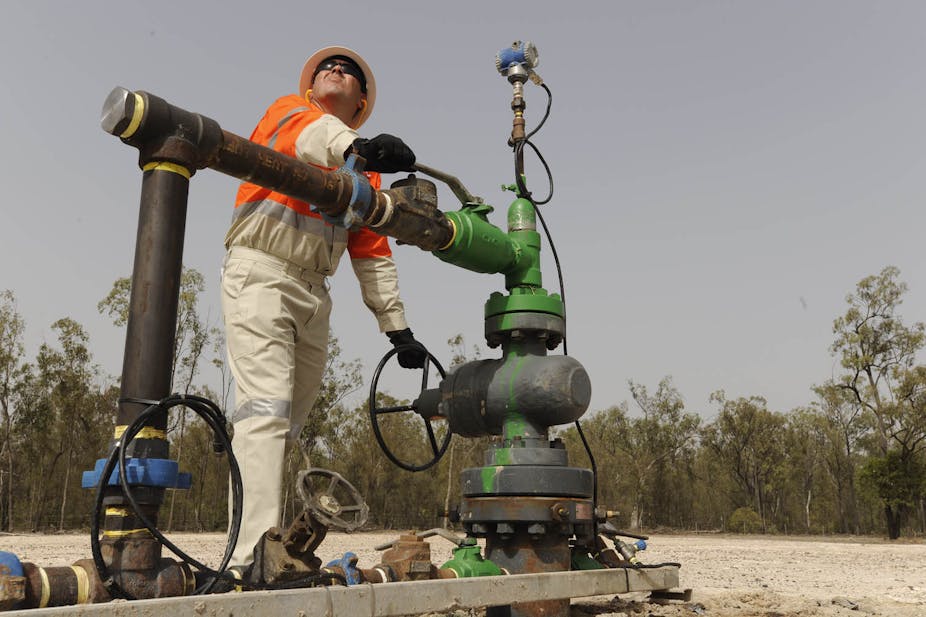While New South Wales and Queensland have moved to exploit unconventional gas resources, Victoria maintains a ban on hydraulic fracturing (“fracking”) for onshore shale gas and coal seam gas (CSG).
Those against are concerned at the potential for adverse impacts on the environment; those in favour argue it will be a valuable new source of gas.
Recent moves in the Victorian government to prioritise mining suggest that unconventional gas could soon get the green light. But how much unconventional gas is in Victoria, and what might be the impacts?
A recent review from the Australian Council of Learned Academies sheds light on these questions.
How much unconventional gas in Victoria?
In the past Victoria has produced large quantities of conventional gas (gas trapped in deep, permeable sandstones). Most of this has been produced offshore in Bass Strait. Victoria has benefited greatly from this resource economically, but production is now decreasing. Victoria has also produced small amounts of conventional gas onshore in the Otway Basin.
We know there is some CSG, and it is likely there is also shale gas. Our report provides an estimate of reserves of 9 trillion cubic feet of shale gas resources in the Otway Basin. This is a lot of gas — sufficient to meet all of Victoria’s current gas needs for thirty years.
But there are great uncertainties attached to such numbers. It is only by drilling and carefully assessing the data that such uncertainties can be removed. So for the moment we really do not know if there any commercially significant shale gas (or CSG) deposits whatsoever in Victoria, but the rocks appear to be favourable.
What are the likely impacts?
There is no question that some early shale gas developments in the US extended over large and produced significant environmental impacts. These included surface disturbance, destruction and fragmentation, and loss of habitats and ecological communities.
But drilling technologies have greatly improved in recent years, and much of these impacts can be avoided.
Another concern for unconventional gas is groundwater. Producing shale gas and CSG have different impacts on water resources. In general, extraction of shale gas does not require extraction of large amounts of groundwater as is the case with many CSG deposits. But risks to groundwater can arise from drilling through aquifers, from spillage or injection of fracking fluids, or from well failures.
The ACOLA review suggest the risk of these accidents is small, and that the industry is very familiar with managing these risks. But Victoria will need an enforced regulatory regime.
What about fracking?
The word fracking appears to have become a highly emotive word for many people. But it is a process that has been used for many years by the oil and gas industry around the world, including in offshore Victorian basins, to stimulate oil or gas production from low permeability sands.
All shales have to be fracked to produce gas (or oil), which involves injecting fluids (primarily water and sand) at high pressure into “tight” rocks to produce fractures extending tens to hundreds of meters into the shale, so that the gas (or oil) can then flow into the production well.
Concerns include the potential for contamination of aquifers, or excessive use of water for fracking, or the potential for generating small seismic events (mini “earthquakes” that are too small to feel but which can be detected using sensitive instruments).
There are very few cases where seismicity can be related to fracking, despite the fact that there are thousands of fracks carried out every year, particularly in North America. Nonetheless we need clear protocols to be in place for hydraulic fracturing and for thorough investigations of any existing faults, before any fracking is carried out. This needs to be backed up by rules on monitoring, including the requirement to cease operations, if there is any evidence of increased microseismic events.
Our review did not consider CSG in any detail, so let me make some personal observations. The CSG deposits in Victoria are associated with geologically young brown coals. They are very different to the Queensland and NSW deposits and we do not really know how much CSG is present or can be extracted.
New approaches and perhaps new technologies will be needed if Victoria’s CSG deposits are to be commercially exploited and as in shale gas there will be a need for effective transparent regulations particularly on groundwater, but it is very unlikely indeed there will be any fracking of Victorian coals.
Unconventional gas developments in Victoria and elsewhere will require careful management of any impacts, an informed and supportive community and transparent and effective regulations so that the state, and Australia, can benefit from a new energy option.

